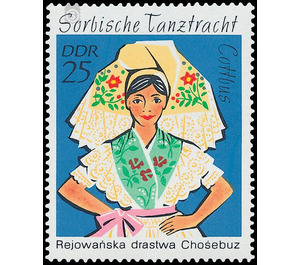Commemorative stamp series - Germany / German Democratic Republic 1971 - 25 Pfennig
Theme: Art & Culture
| Country | Germany / German Democratic Republic |
| Issue Date | 1971 |
| Face Value | 25.00 |
| Color | multi-colored blue |
| Perforation | K 13 1/2 |
| Printing Type | offset |
| Stamp Type | Postage stamp |
| Item Type | Stamp |
| Chronological Issue Number | 1412 |
| Chronological Chapter | GER-DDR |
| SID | 764563 |
| In 13 Wishlists | |
Sorbian Dance Costumes The Ministry of Posts and Telecommunications of the German Democratic Republic issues four multicolored special postage stamps with pictures of Sorbian dance costumes. Sorbische Tanztrachten Today's Sorbian costumes are remnants of formerly closed costume landscapes. Part of the female rural population of the middle and older generation still wears traditional costumes here in their daily lives. The costume of the men has already been filed in the last century, only some of its elements have been preserved to the present day. The bilingual circles of the districts of Dresden and Cottbus still have four different Sorbian costumes. Each is characterized by a variety of functional and age-related variants. Among them, especially the festive costumes are distinguished by their great wealth of forms, colors and folk art design. The Sorbian folk costumes document the creative power of the working people as well as the past as well as the present. In continuation of the 1968 published series Sorbian Festtrachten present special postage stamps represent the festive dancing costume of the girls dar. This is characterized by a special richness of color costume is created on special occasions by the female youth, even if she is not one of the permanent costume bearers. Sorbian folk art collectives like to use this costume for their youthful freshness as a stage costume. Niedersorbische Tracht - Cottbus (25 Pfennig value) Approximately 40 villages of the eastern, northern and western area around Cottbus including the Spreewald belong to this costume area. The costume has numerous locally bound deviations with approximately the same basic form. For example, the hometown of the wearer can be identified by the binding style of the three-part headscarf. The proximity of larger cities and not least of all Berlin, where many traditional dressmakers were employed as maids, as well as the tourism, which was intensified especially in the Spreewald, has effected in the past 50 years an unmistakable influence of the urban fashion, which predominantly in the coloring and Auszier (embroidery) has found its expression. Elementary colors were largely replaced by pastel shades and ornamental embroidery by naturalistic forms.


